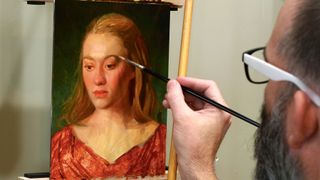Painting a portrait in oils has always been one of the most popular ways to create art. Galleries are packed full of portraits of famous and not-so-famous faces captured in oil paint and displayed for the world to see. But it isn't always a straightforward process, and there is a lot you can do to improve your process. This guide is here to show you exactly how to emulate those prestigious works of art.
- Pen
- Oil paint
- Canvas
- Paintbrushes
It may not be easy, but there are steps to follow to help you on your way. In this tutorial, Howard Lyon shares his process from blocking in the shadows to developing the form and making each brushstroke count. So, grab all the oil paint supplies you need, including the best oil paints and get started.
Painting a portrait in oils
01. Draw with a grid

I use a grid to create my drawing. I use pencil for the grid and when the drawing is done, I ink the important lines with a Micron Pigma Pen or India ink and then erase the grid. I also like to use a warm colour to start with. Bear in mind that the tint of your canvas will affect your final painting (pick from the best oil paint canvas options here). Little patches of it will show through and add vibrancy.
02. Create an imprimatura on the canvas

The imprimatura is usually one or two pigments that are thinly painted over a toned canvas. Here I'm using Raw umber and Light red. This is the stage to focus on establishing the shadow shapes. Don't worry about perfect edges and brushstrokes. This stage is simply about creating accurate shapes. Let the paint be a bit washy in places. The variation is interesting, and will show through and add depth. (Need more kit? Choose from the best art supplies around.)
03. Establish the colour in your oil portrait

Now we begin to establish the colour for the flesh. Look for middle values in the light side and avoid the highlights for now. Like Frankenstein's creation, parts are coming together, but it still looks a little monstrous. Don't panic – slow and steady work will win the day. Keep your flesh colours simple, using only two or three pigments. Keep the "mud" out of your colours by mixing with like-temperatures. You can neutralise your colours with a grey of the same value.
04. Define the figure's forms

Now that the colour and values are in place we can start to work the transitions from dark to light. Try to mix the right colour rather than blending on your canvas. This will train your eye and improve your ability to mix colour. Focus at this stage and aim to mix the right colour with each stroke. Remember not to lose the big shapes as you refine the forms.
05. Finish with style!

Don't be afraid to make artistic decisions throughout the painting process. You aren't a slave to your subject. I'll often add splashes of bright colour to the background and subject in the final moments. It adds vibrancy and is a lot of fun! This painting has a green/red palette that adds a strong energy. Analogous or monochromatic palettes are useful when creating mood.
This article originally appeared in ImagineFX issue 149. Subscribe here (opens in new tab).
Related articles:
- Oil painting techniques: Tips to help improve your work
- Paint water in oils: Create a rippling effect
- How to clean paintbrushes: The definitive guide

